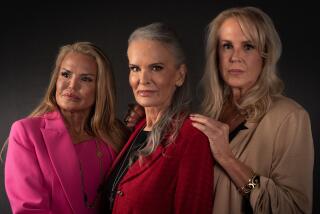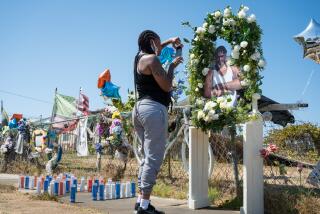Defense Pulls Pro Wrestling Into Murder Trial
- Share via
FORT LAUDERDALE, Fla. — Did a 12-year-old boy murder his younger playmate in what prosecutors have termed “a brutal, savage beating”? Or did Tiffany Eunick die accidentally as she and Lionel Tate imitated what he had seen his muscled heroes do on TV?
Those are the questions that a jury will begin to weigh today in a first-degree murder trial that has gained national attention because of the age of the accused--now 13--and his novel defense.
Lionel caused the July 1999 death of 6-year-old Tiffany because his exposure to professional wrestling “makes him believe he can be like the wrestlers, and no one gets hurt,” defense attorney Jim Lewis said Wednesday. But, Lewis added, the boy is not guilty of murder because he “is not mature enough to reflect on the consequences of his actions.”
Before the trial began two weeks ago, Broward County Judge Joel T. Lazarus quashed defense subpoenas aimed at compelling testimony from Dwayne “The Rock” Johnson, Steve “Sting” Borden and Terry “Hulk Hogan” Bollea. The World Wrestling Federation has filed a suit claiming it was defamed by Lewis, and the organization is watching the trial closely.
But Lewis still was able to make his argument that Lionel--at the time of the death an immature 166-pound sixth-grader with a low-average IQ--was imitating what he saw on TV when he flung the 48-pound Tiffany into a metal staircase after asking her: “Do you want to play wrestling?”
Lewis showed the 12-member jury a Sprite soda commercial in which wrestling star Sting picks up a young boy and uses him as a battering ram. He also screened a clip from a match in which another wrestler, The Rock, smashed a foe headfirst into an iron gate. “If that doesn’t send a wrong message to kids like Lionel, I don’t know what does,” Lewis said. “It makes him want to play wrestling all the more.”
Assistant State Atty. Ken Padowitz countered that pro wrestling had no role in Tiffany’s death--and no place in the courtroom. “TV violence is not on trial. Professional wrestling is not on trial. And whether there’s too much violence--in the media or in sports--is not on trial. It’s not an excuse for murder.
“This was a savage, brutal beating.”
Lionel, who has been under house arrest since being charged a year and a half ago, is one of the youngest defendants in Florida ever to be treated as an adult in a homicide case. Before the trial, he and his mother--Kathleen Grossett-Tate, a Florida Highway Patrol officer who was upstairs sleeping when the death occurred--turned down a plea deal that would have sent Lionel to a juvenile facility for three years, followed by 10 years of probation.
If convicted of first-degree murder, he could be sentenced to life in prison, with the possibility of parole coming when he turns 38. Jurors also could find him guilty of a lesser charge of second-degree homicide or manslaughter.
The nexus between televised violence and real acts of brutality is unclear. In 1977, Miami lawyer Ellis Rubin gained national attention for arguing that his client, 15-year-old Ronnie Zamora, suffered from “TV intoxication” when he shot and killed an elderly neighbor. The jury didn’t buy it, and Zamora is serving a life term in prison.
Earlier this month, U.S. Surgeon General David Satcher issued a report that showed a link, albeit small, between graphic TV violence and increased aggression among children. And professional wrestling, in which the combatants escape injury as they pummel each other with fists, clubs and chairs, has never been more popular.
In his closing argument, Lewis said that Lionel “purposefully slung [Tiffany], punched her; he may even have purposefully done a knee-drop on her.”
“I’m not saying Lionel didn’t show some poor judgment,” Lewis said. “But it doesn’t rise to the level of great bodily harm, or intent to kill that little girl.”
In his final words to the jury, Padowitz recalled testimony from medical experts--including a pathologist who testified for the defense--who concluded that the injuries were so severe they could not have been accidental. One expert said Tiffany’s injuries compared to those suffered by unsecured passengers in a head-on car crash.
To buttress his case that Tiffany was a victim of deliberate aggravated child abuse, the prosecutor held up for jurors a life-size photograph of her naked body, which had been labeled with more than 35 injuries and wounds, including a detached liver.
Padowitz also reminded jurors of Lionel’s initial statements to police, in which he denied any involvement in the injuries to Tiffany, the daughter of a family friend.
As for motive, Padowitz suggested that Lionel might have wanted to get rid of Tiffany because he had a crush on her mother, Deweese Eunick-Paul, and wanted Tiffany’s toys.
In her testimony last week, Eunick-Paul said that she had recognized the schoolboy crush. The day after the death, she added, Lionel had asked if he could live in her house. But Eunick-Paul also said that Tiffany and Lionel had played well together.
“I would like to see whatever God wants to happen, that’s going to happen, and I have to live with it,” she said. “So frankly, if he gets a year, if he gets 20 years, it’s not going to make any difference to me, because my daughter is never coming back.”
More to Read
Go beyond the scoreboard
Get the latest on L.A.'s teams in the daily Sports Report newsletter.
You may occasionally receive promotional content from the Los Angeles Times.










